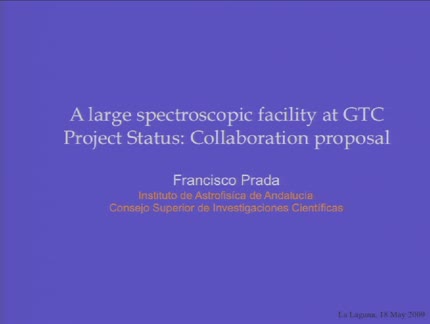Found 14 talks width keyword Local Group

Abstract
Massive stars dominate the light output of entire galaxies, with luminosities in excess of 105 L⊙. This makes them powerful probes with which to study a range of astrophysical phenomena. In this talk I will review the recent results of our group, in which we have been able to shed new light on the recent star-forming history of our Galaxy, and the nature of supernova progenitors. I will also discuss our latest project, which is to use massive stars as tracers of extra-galactic star-forming histories out to distances of 10 Mpc and beyond.

Abstract
In the next decade astronomers will attempt to constrain the nature of dark matter, dark energy and the (perhaps inflationary) processes which generated structure as well as understanding the astrophysics of galaxy evolution and the formation and evolution of our Milky Way and Local Group. Large-scale spectroscopic surveys on large telescopes will be critical to achieving reliable results in all these areas. The desideratum is a survey which obtains the spectra of a few times 105 galaxies from the visible into the near IR at each of a sufficient number of redshift slices that one can follow the evolution of all interesting populations. Large samples of different stellar populations in different Local Group environments will also be targeted. I will summarize the outline of a multi-object 0.4-1.7 μ spectrograph for GTC and discuss the status of miniSIDE. MiniSIDE has been conceived as a pathfinder for a large fiber-fed survey spectrograph but will be a scientific instrument on its own, capable of providing high quality science data and be competitive within the instrumentation suite of GTC. A Letter of Intent has been submitted recently to propose miniSIDE as a facility science instrument for GTC.

Abstract
I will review the status of our understanding of galaxy formation in the prevailing cold dark matter paradigm. After reviewing the successes and failures of the most natural predictions of this scenario I will focus on the consequences of two of its main predictions: the presence of large numbers of low-mass dark matter halos and the prevalence of accretion events during the formation of normal galaxies. In particular, I will discuss the interpretation of the recent discovery of a population of ultra-faint galaxies in the Local Group, and its relation to the profuse cold dark matter substructure expected in the Galactic halo. I will also discuss the importance that accretion events might have had in shaping not only the stellar halo but also the disk component(s) of the Milky Way.

Abstract
Based on observations with the Advanced Camera for Surveys (ACS), I will present accurate relative ages for a sample of 64 Galactic globular clusters. This Hubble Space Telescope (HST) Treasury program has been designed to provide a new large, deep and homogeneous photometric database. Relative ages have been obtained using a main sequence fitting procedure between clusters in the sample. Relative ages are determined with an accuracy from 2% to 7%. It has been proved that derived ages are independent of the assumed theoretical models. The existence of two well defined Galactic globular cluster groups is found. A group of old globular clusters with an age dispersion of 6% and showing no age-metallicity relation, and, on the other hand, a younger group showing a clear age-metallicity relation similar to that found in the globular clusters associated to the Sagittarius dwarf galaxy. Roughly 1/3 of the clusters belong to the younger group. Considering these new results, it is very tempting to suggest a Milky Way's halo formation scenario in which two differentiated phases took place. A very fast collapse, where the old and coeval globular clusters where formed, followed by accretions of Milky Way's satellite galaxies.
<< First « Newer 1 | 2 Older »
Upcoming talks
- Runaway O and Be stars found using Gaia DR3, new stellar bow shocks and search for binariesMar Carretero CastrilloTuesday April 30, 2024 - 12:30 GMT+1 (Aula)
- Detecting GWs in the muHz: natural and artificial satellites as GW detectorsProf. Diego BlasThursday May 2, 2024 - 10:30 GMT+1 (Aula)









